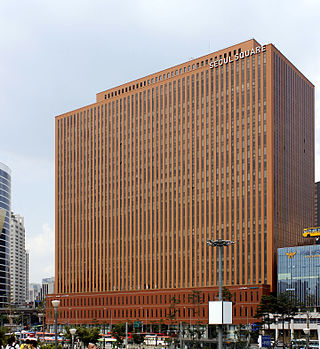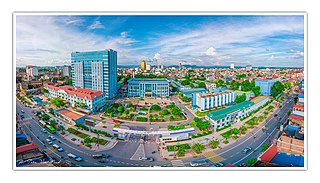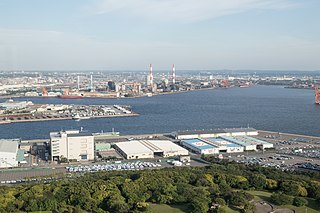
The economy of Mexico is a developing mixed-market economy. It is the 12th largest in the world in nominal GDP terms and by purchasing power parity according to the International Monetary Fund. Since the 1994 crisis, administrations have improved the country's macroeconomic fundamentals. Mexico was not significantly influenced by the 2002 South American crisis, and maintained positive, although low, rates of growth after a brief period of stagnation in 2001. However, Mexico was one of the Latin American nations most affected by the 2008 recession with its gross domestic product contracting by more than 6% in that year.

The economy of South Korea is a highly developed mixed economy. By nominal GDP, the economy was worth ₩2.24 quadrillion. It has the 4th largest economy in Asia and the 12th largest in the world. South Korea is notable for its rapid economic development from an underdeveloped nation to a developed, high-income country in a few generations. This economic growth has been described as the Miracle on the Han River, which has allowed it to join the OECD and the G20. South Korea remains one of the fastest-growing developed countries in the world following the Great Recession and the COVID-19 recession. It is included in the group of Next Eleven countries as having the potential to play a dominant role in the global economy by the middle of the 21st century.

The economy of Vietnam is a developing mixed socialist-oriented market economy incorporating industrial policies and strategic five-year plans, which is the 35th-largest in the world as measured by nominal gross domestic product (GDP) and 26th-largest in the world as measured by purchasing power parity (PPP) in 2022. It is a lower-middle income country with a low cost of living. Vietnam is a member of the Asia-Pacific Economic Cooperation, the Association of Southeast Asian Nations and the World Trade Organization.

Daewoo also known as the Daewoo Group, was a major South Korean chaebol and automobile manufacturer.
A chaebol is a large industrial South Korean conglomerate run and controlled by an individual or family. A chaebol often consists of multiple diversified affiliates, controlled by a person or group. Several dozen large South Korean family-controlled corporate groups fall under this definition. The term first appeared in English text in 1972.

LG Electronics Inc. is a South Korean multinational major appliance and consumer electronics corporation headquartered in Yeouido-dong, Seoul, South Korea. LG Electronics is a part of LG Corporation, the fourth largest chaebol in South Korea, and often considered as the pinnacle of LG Corp with the group's chemical and battery division LG Chem. It comprises four business units: home entertainment, mobile communications, home appliances & air solutions, and vehicle components. LG Electronics acquired Zenith in 1995 and is the largest shareholder of LG Display, the world's largest display company by revenue in 2020. LG Electronics is also the world's second largest television manufacturer behind Samsung Electronics. The company has 128 operations worldwide, employing 83,000 people.

Thái Nguyên is a city in Vietnam. It is the capital and largest city of Thái Nguyên Province. The city is listed as a first class city and is the ninth largest city in Vietnam. It has long been famous throughout Vietnam for its Tân Cương tea, among the most recognized Vietnamese tea regions. In 1959, it become the site of Vietnam's first steel mill, and is now home to a large and growing major regional university complex.

The Japanese electronics industry is one of the largest in the world, though the share of Japanese electronics companies has significantly declined from its peak due to competition from South Korea, Taiwan, China, and the United States.

Japan's major export industries include automobiles, consumer electronics, computers, semiconductors, copper, and iron and steel. Additional key industries in Japan's economy are petrochemicals, pharmaceuticals, bioindustry, shipbuilding, aerospace, textiles, and processed foods.
Soitec is an international company based in France, that manufactures substrates used in the creation of semiconductors.
The Defence Industry of Pakistan, established in September 1951, mainly falls under the purview of the Ministry of Defence Production (MoDP). It aims to foster collaboration and oversee the diverse range of military production facilities that have emerged since Pakistan's independence. The MoDP comprises specialized organizations, each dedicated to various aspects of the defence industry, including research and development, production, and administration.

Industry is 39.4% of China's gross domestic product (GDP) in 2022. In 2007, industry contributed 46.7 percent of GDP in 2010 and occupied 27 percent of the workforce. In 2015, the manufacturing industrial sectors contributed to 40% of China's GDP. The manufacturing sector produced 44.1 percent of GDP in 2004 and accounted for 11.3 percent of total employment in 2006.
The East Asian model, pioneered by Japan, is a plan for economic growth whereby the government invests in certain sectors of the economy in order to stimulate the growth of specific industries in the private sector. It generally refers to the model of development pursued in East Asian economies such as Japan, South Korea, Hong Kong and Taiwan. It has also been used by some to describe the contemporary economic system in Mainland China after Deng Xiaoping's economic reforms during the late 1970s and the current economic system of Vietnam after its Đổi Mới policy was implemented in 1986. Generally, as a country becomes more developed, the most common employment industry transitions from agriculture to manufacturing, and then to services.

The automotive industry in South Korea is the fifth-largest in the world as measured by automobile unit production and also the sixth-largest by automobile export volume.
The electronics industry in Bangladesh is one of the fastest-growing industries in the country with great potential. Popular Bangladeshi electronics brands include Walton Electronics, Singer Bangladesh, Jamuna Electronics, Vision Electronics. Local companies such as Fair Group, Butterfly Group, Electra, Rangs Group, Electro Mart, and Transcom Group manufacture and assembles Electronics Home Appliances in collaboration with foreign brands such as Samsung, Whirlpool, LG, Sony, Gree, Konka, and Sharp.

Samsung Group is a South Korean multinational manufacturing conglomerate headquartered in Samsung Digital City, Suwon, South Korea. It comprises numerous affiliated businesses, most of them united under the Samsung brand, and is the largest South Korean chaebol. As of 2020, Samsung has the eighth-highest global brand value.

Samsung Electronics Co., Ltd. is a South Korean multinational major appliance and consumer electronics corporation headquartered in Yeongtong-gu, Suwon, South Korea. It is currently the pinnacle of the Samsung chaebol, accounting for 70% of the group's revenue in 2012.
Early in the twenty-first century, foreign investment as well as government regulations and incentives promoted growth in the Indian electronics industry. The semiconductor industry, which is its most important and resource-intensive sector, profited from the rapid growth in domestic demand. Many industries, including telecommunications, information technology, automotive, engineering, medical electronics, electricity and solar photovoltaic, defense and aerospace, consumer electronics, and appliances, required semiconductors. However, as of 2015, progress was threatened by the talent gap in the Indian sector, since 65 to 70 percent of the market was dependent on imports.
The defense industry of South Korea is the main supplier of armaments to the Republic of Korea's Armed Forces. Originally reliant on the United States to supply weapons to its armed forces, South Korea started to manufacture its own weapons through the country's modernization and military reforms. Today, South Korea enjoys a robust defense industry and is the world's 8th largest weapons exporter.

South Korea's major export industries include semiconductors, automobiles, and shipbuilding. Other major industries in South Korea are electronics, telecommunications, chemicals, and steel.












